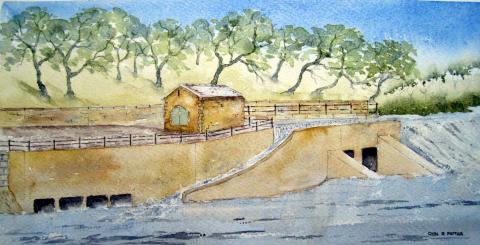A Kaplin (propeller type) turbine will be installed on Forge Weir below a small, purpose built building, whose stone cladding and roof made with local slate, will ensure it blends into the landscape.
The weight and energy of the water will turn the turbine, driving a generator, which will produce electricity. The electricity generated will receive revenue from the Hydro Feed-in Tariff. This is a government scheme which guarantees payments for producers of renewable electricity-generating technologies including hydroelectric energy. Electricity will also be sold to the pioneering Lancaster Cohousing eco community situated half a mile downstream, and to the National Grid.
The Environment Agency, fishery owners and anglers have been consulted from an early stage. Great care has been taken to include environmental improvements, such as river bank protection and improved fish and eel passage over the weir, through new best practice fish and eel passes. Migrating fish like salmon need to swim up stream to get to their breeding grounds, but man-made obstacles, like weirs, can stop them from doing this. These passes act like ladders to help fish and eels go up and down the weir more easily.
Building work starts in December 2013 and we expect to start generating electricity in Autumn 2014. The building has been designed to accept a second turbine, financed through a separate share offer. This will be installed after the first has been operating successfully for 12 months.
Technical Information
Turbine : High Efficiency Kaplan, underground. Head: 2m
Building: Reinforced concrete structure, stone clad with local slate roof
Electrical Output: c. 160kWe at 440v and 11KV for grid transmission
Generation pa: 1,005Mwe hr average.
The turbine is to be built into the old leat off-take on the North bank and discharging directly below the weir. The proposed scheme will therefore only use the head available over the weir. The original proposal was to maximise the head by discharging 100 m downstream of the weir. This would have created a significant deprived reach and it was agreed, through consultation with Fishtek Consulting, that an on-weir scheme sacrificing some power generation would be preferable from a fisheries perspective.
The scheme will take up to a maximum of 12 m3/s (approximately 1/3 of Qmean) with a proposed Hands Off Flow (HOF) of Q90, equal to 4.74 m3/s. The hydropower system will be comprised of two Kaplan turbines, installed side by side, taking a total combined flow of 12 m3/s. Upstream of the turbines there will be a fine, 10 mm screen and a new fish pass will also be installed alongside the turbines (see section 5).
The HOF at the site will be split between the existing fish pass on the South bank of the weir (see figure 2), the new fish pass beside the turbines and the weir crest (including the apex pass).
 Halton Lune Hydro The biggest community hydro in England
Halton Lune Hydro The biggest community hydro in England


